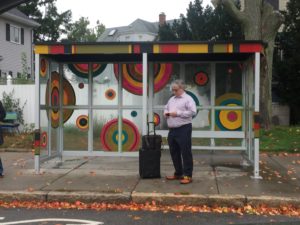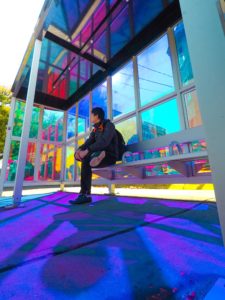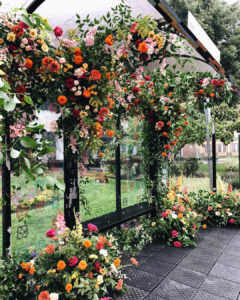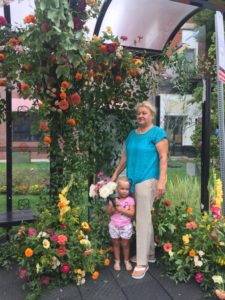
The Greater Boston region has received much attention for its worst-in-the-nation rush hour congestion problem, where in 2018 commuters lost an average of 164 hours in rush-hour traffic. Several Boston area municipalities are looking for innovative solutions that rethink urban streets to manage the region’s traffic. Bus improvements have become a hot topic and are proving to be the solution that offers high impact for a low relative cost.

In a partnership funded by the Barr Foundation, ITDP worked with four Boston-area municipalities and other technical consultants to pilot various combinations of bus rapid transit elements. By creating bus priority in Arlington, Everett, Cambridge, and Watertown – through dedicated and shared bus and bike lanes, queue jumps, transit signal priority, and platform level boarding. Throughout the pilots there were improvements in bus travel times and a demonstration among the public of the appetite for reconsidering collective use of street space.
ITDP gathered the pilot municipalities to present their processes and learnings to other transit planners and municipal leaders throughout the Greater Boston area. Across the projects, there were several common themes to success.
Planning and Partnership

Each of the pilots demanded close coordination of stakeholders, including across municipalities and agencies. Cities and towns control their streets, but the transit agency owns the bus fleets – so to get the bus and traffic signals to talk to each other required many human-to-human conversations. Furthermore bus improvement projects are not standalone initiatives. Incorporating these plans into existing roadway redesigns required additional coordination with statewide agencies so that the final product included broad community buy-in. Finally, working through a private funder as part of an outside consultant team, ITDP was able to ensure that every technical aspect was approached with the knowledge and understanding of best practices from its work on bus rapid transit in other cities.
Communications and Enforcement
Getting each community’s buy-in to test these elements required navigating various public processes. ITDP coordinated a set of street teams to talk to people traveling on each pilot corridor to share details on the new street and service changes and educate generally about bus rapid transit. Municipal staffers went door-to-door in the Cambridge pilot area to ensure nearby residents understood the new travel patterns. Each of the pilot communities also utilized websites and social media to boost awareness of the specific street changes within their constituencies.
On-street message boards in each community warned drivers of new traffic patterns. While Cambridge, Watertown, and Arlington hosted formal public meetings, the City of Everett used the pilot as the public process, relying on red paint and cones – and some media attention – to build awareness and support for bus priority. Those bright orange cones helped not only draw attention to the project, but also ensured that cars stayed out of the new priority lanes. Especially at the launch of these pilots, local police departments played a critical role in enforcing the lane’s restricted use and keeping automobile traffic flowing.

Rider Experience Matters
Though the goal of these pilots was to show how BRT elements can improve the travel time and reliability of local buses, ultimately the goal of bus improvements is to enhance the rider experience. To demonstrate the success to the larger community and political actors, anecdotes from people who benefited by saving time were just as important as quantitative data. A video of Arlington’s dedicated lane went viral on Twitter, with residents commenting how much better their commutes have become, regardless of mode.
In addition to the time savings on the bus, creative marketing and branding infused fun into each pilot. In Everett, local Instagram influencer @BostonPollen (Chrissy Price) activated one of the new level boarding platform with a full-scale “flower bomb.” The Town of Arlington curated bus shelter installations from five local artists to bring #ARTBRT to life. Banners along Mt. Auburn Street in Cambridge and ads in bus shelters reinforced the people-centric nature of bus priority, with slogans like “dedicated lanes dedicated to you” and “bus first means you first.” These creative elements lifted up the entire concept of the bus, improving the waiting experience as well as the ride.
The Road Ahead to BRT
So how does the Boston area go from bus improvements to implementing bus rapid transit? It takes political will and coordination between the municipality and the MBTA. These small scale “quick build” projects are an intermediate step to meet the region’s ambitious mode shift, equity, and climate goals.
Municipal leaders can and should be bold and ambitious with their transit visions, thinking carefully about how they and their constituents want to use public streets. These small improvements, across small geographies, yielded significant time savings and greatly improved rider experience. Plus, post-pilot survey data shows they also made commutes easier for people driving and biking.
A full bus rapid transit corridor could be a powerful solution to Greater Boston’s big congestion problem. Combined with other sweeping investments in transit – like new pricing strategies, parking policies, and expanded bicycle and pedestrian infrastructure – a BRT corridor that connects people to the places they need to be can enhance the entire region’s transportation network.
We’re hiring a Public Transit Manager based in Boston! Learn more about the position and apply here.
See more information about BostonBRT here.





